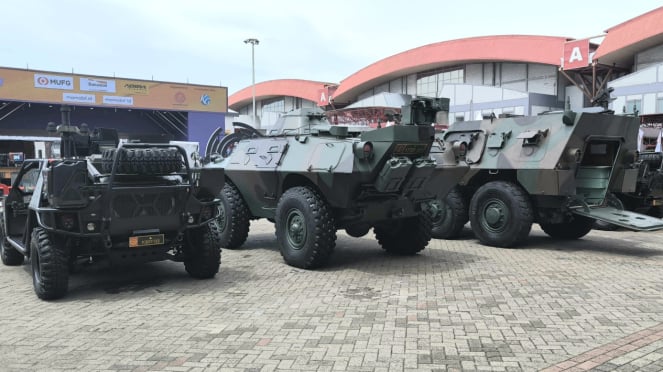Rabu, 19 Februari 2025 – 14:40 Bungkus
Jakarta, Viva – Pameran Indonesia (IIMS 2025), Pusat Jakpo Shipmayar, sekarang ia masih menunjukkan kendaraan Angkatan Darat untuk Angkatan Darat.
Baca juga:
Di Marto Muhammad Syafi mendekati istana, dibuka sebagai Kabasrulf?
Kemudian layar memiliki semi-kendaraan. Ptzer V-150 AP, Pant Pe Petdas dan P6 ATAV (Alat menyerang seluruh tanah).
Diketahui bahwa 2025 dirancang untuk melatih kendaraan tempur milik IIM, serta publik tentang fungsi kendaraan sebagai alat foto.
Baca juga:
Balap ke persyaratan Toyota Gazoo tentang orang Indonesia
Berengsek
TNI Majish TNI Vehic IMIMS pada tahun 2025
“Selain datang ke kendaraan ini untuk tahun 2022, kendaraan ini juga akan ditanyakan bersama. Lalu kami memberikan informasi singkat,” kata seorang anggota TNIS Viva Pada hari Rabu 19 Februari 1925.
Baca juga:
Jatuh di Kia Carnival dan XIMS 2025 dengan harga karnaval dan mobil
Meskipun keduanya digunakan untuk status perang atau perang, ketiga model memiliki fungsi yang sesuai.
“Untuk kapasitas SSA, dalam perkelahian kota ini, pertempuran kota ini digunakan untuk pertempuran hutan. Jika Anda perlu bekerja dengan cepat,” katanya.
Model ANA 6X6 dibedakan oleh kapasitas dan kapasitas 8 penumpang.
“Ano 6×6 adalah situasi kota ini, itu adalah pembom spiritual secara mental. Kendaraan ini secara mental Jakarta dan total 10 tahun,” kata Tni A ‘secara umum.
Layar digunakan untuk menempatkan tentara di acara militer di sebuah acara militer.
Berengsek

TNI Majish TNI Vehic IMIMS pada tahun 2025
“V-150 ini adalah kapasitas 12 orang dan digunakan untuk menempatkan tentara jika ada perang. Itu dibuat pada tahun 1971 di Amerika,” katanya.
Ketiga WAG ini dapat pindah ke sifat teknis kendaraan, untuk mencapai 60 cm untuk Panter V-150 AP. Kecepatan maksimum kendaraan ini mencapai 99,9 km per jam dan didukung karena fakta bahwa 300 liter.
Kemudian, model ANA 6X6 yang diproduksi oleh Pt Pie, memiliki 320 tenaga kuda pada 2.300 rp, dan 1.200 nm 1.200 nm. 1700 rpm.
Dengan transmisi otomatis model ZF 6HP5HP5HP502, kendaraan ini adalah 6 kecepatan lanjutan dan 1 kembali. Untuk mengoperasikan kendaraan ini dapat mencapai kecepatan 10 km dengan kecepatan 10 km 10 km.
Peluang operasi lainnya hingga 60% (berenang hingga 30,69 derajat), jarak hingga 1,5 meter 600 km. Selain itu, kendaraan ini memiliki 35% (16,69 derajat), mencapai 45 derajat dan sudutnya dibiarkan ke kiri 45 derajat.
Akhirnya, model Ethma P6 PT Surya mengembangkan pertahanan dalam imajinasi (pertahanan). 2500 cc ditenagai oleh 4-cc.
Dengan kapasitas 120 liter, kendaraan ini kecepatan 120 liter, dengan kecepatan hingga 500 km per jam dan 120 km per jam. Kendaraan ini dirancang untuk mendukung operasi militer dengan mobilitas besar dan daya tahan yang dapat diterima di berbagai bidang.
Halaman berikutnya
Model ANA 6X6 dibedakan oleh kapasitas dan kapasitas 8 penumpang.





